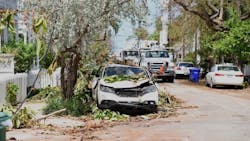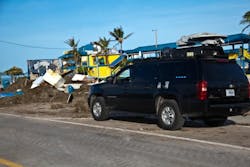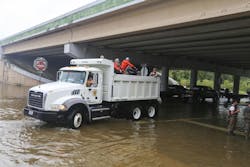As an innovator in intelligent machine-to- machine (M2M) wireless technology and industrial applications of the Internet of Things (IoT), Ken Ehrman has been awarded more than 20 patents in wireless communications, mobile data, asset tracking, power management, plus cargo and impact sensing. He founded I.D. Systems in 1993 as a Stanford University engineering student, to develop the use of radio frequency identification (RFID) technology for industrial asset management. Now as a technology advisor to industrial clients, Ehrman shares his thoughts in this guest column on how truckers can better protect their technology investments from the wrath of Mother Nature.
This year has seen major devastation throughout the 2017 hurricane season. The destruction caused by Harvey, Irma, Maria and more, wrought havoc—destroying lives and businesses in their paths.
In the same way that homes in high-risk areas can be built with disaster-ready precautions, transportation providers need to factor fail-safes into their IoT architecture.
This is particularly valuable when IoT solutions provide the location and status of much-needed supplies entering an area to help with recovery.
Even if your company isn’t involved in relief efforts, the benefits of these fail-safes will also help executives strengthen their company’s tracking system, improve the connectivity of trucks and other assets, protect data collection, then track and relocate lost assets in less time.
Ultimately, truckers with a disaster-ready IoT architecture in place will recover from a natural disaster more quickly.
Whether general IoT architecture is large and centralized or data is gathered “on the edge” for day-to-day monitoring, the root of IoT architecture begins with a robust system for collecting data from assets.
When considering an IoT disaster-ready solution, turn your attention to the tracking devices themselves. I suggest looking for “Four Factors” when seeking robust disaster-ready solutions, including: a hardened plastic enclosure, quality battery life, the correct environmental certifications, and consistent network connectivity.
It is important to note that these qualities are also beneficial during daily asset operations regardless of environmental risk. I therefore urge all companies to adhere to most, if not all, of these stipulations.
Hardened Plastic Enclosures: The basic design of IoT devices must be hardened with robust plastic enclosures to survive the toughest of elements. Hardened plastic enclosures are more reliable than metal, due in part to the fact that they lack many of the risks that metal enclosures bring.
Metal can attract electrical shocks, causing the device to either short out, or disrupt the device’s electrical signals. Hardened plastics help avoid this issue, preserving the integrity of your devices and asset data.
In addition to minimizing shocks, hardened plastics provide the necessary physical protection for your sensors.
The durability of hardened plastic has improved over the years, meaning that it affords a great degree of protection from issues like salt-fog or vibration damage.
Battery Life and Quality Degradation: In the event of a natural disaster, IoT devices may be without power for an extended period. Because of this, it is critical to evaluate how long the devices provide full functionality without power, as well as whether they “gracefully degrade” over time.
This is essential because it maximizes your device’s ability to gather and transmit information – even if an asset has been thrown or moved somewhere during high winds and the device cannot be found for recharging.
Quality degradation is the other half of the battery equation and is just as important in the event of a hurricane or other natural disaster. The ability to “gracefully degrade” refers to the device’s ability to transition from full power to a sustainable, low-power alternative when the battery’s reserves begin to be depleted.
If your device’s battery design is high-quality, this ability to gracefully degrade prolongs the battery life even further, meaning that you have additional days and sometimes months to locate any assets that may have been caught in a storm.
Certification Requirements: There are many different device options out there, some of which are tested to various classes of operational performance in vibration, shock, wind, rain, snow, temperature fluctuation, salt-fog, dust, dirt, mud, etc.
However, some of these devices can still fail at their first encounter with the elements despite their promised level of protection. In order to truly mitigate environmental and operational damage—especially if you want your IoT solutions to work in a hurricane—make sure you buy products with both MIL-810-G and IP-69K certifications.
Preparing up-front with the correct certifications will save you from excess downtime, lost assets, and repair expenses. Needless to say, it’s worth the investment.
Be aware, it’s not only the device that needs to be certified, but the associated sensors need certifications as well.
Consistent Network Connectivity – Satellite vs. Cellular: Arguably, the most important part of any IoT infrastructure is the ability to ensure consistent network connectivity.
If the device is physically robust but unable to transmit any information, your company may still have high quantities of lost assets and cargo.
For those located or operating in high-risk areas, I’ll cover an option of using a multi-channel data collection approach to add an extra layer of protection and ensure your assets’ visibility and safety.
Determining which approach to use is important, because the selection of a network can significantly affect the cost of the device, as well as the ongoing service. Some devices incorporate multiple channels, using the most cost-effective available network for each transmission.
This is an option for those companies which operate in extremely high-risk areas. Using a multi-channel approach creates the best possible chance for continuous, unbroken connections with your assets.
However, this design essentially doubles the cost of the hardware used for communication. To determine whether a multi-channel approach is best for your IoT architecture, consider the pros and cons of satellite vs. cellular as outlined below.
Ideally, your data should be transmitted to a single software platform so that the information is up-to-date regardless of the communication path used—and provider, for that matter.
Two communication channels provide the most hardened approach for continued operation in a natural disaster, but there are tradeoffs if you choose this option.
If you pursue a multi-channel approach, each tracking device needs both a satellite and cellular modem, as well as two antennae.
This method also requires payment for two separate monthly service charges, as well as the cost of time to maintain relationships with two service providers. If your assets are high value and in high-risk areas, you may want to opt for the multi-channel approach despite the additional costs. It could save you from far greater losses in the future.
Then again, you may determine that the risk or value of your assets is not great enough to justify the expenses associated with a multi-channel approach. If this is the case, install a multi-channel system only for those assets that commute frequently in high-risk areas. This is a simpler way to balance your company’s daily costs with a higher level of protection when needed.
If you don’t need a multi-channel solution, I strongly recommend using cellular networks over satellite. Cellular towers are much more hardened than they were even five years ago. Many of them have backup power with generators to keep them up and running, as well as many other disaster-ready hardening techniques.
You may be wondering; can a cell tower sustain service during a hurricane like Irma or Harvey?
In response that very question by the Miami Herald newspaper back in September, Sprint spokeswoman Roni Singleton stated that, “the local building codes dictate how strong cellular towers must be for a given area. There are a lot of variables that impact the code, so there isn’t a simple one-size-fits-all answer, but the codes for Florida are pretty strict.”
She said that while equipment is occasionally damaged on cell towers due to high winds—generally the antennas suffer the most—it is “extremely rare” for a tower to have a structural failure.
Despite her assurances, though, you as a transportation provider should consider what local building codes require. If your area of operation does not require hurricane, earthquake, tornado or other disaster-ready precautions, be aware that the nearby cellular network may be compromised during such an event.
Balance this consideration, however, with the likelihood that a given natural disaster would affect that area. If no building codes are required, this is due to the low risk of an event occurring. If this is the case, then cellular networks are highly likely to be able to resist damage.
Satellite communication is the other available option. Low-Earth-Orbit satellites are typically 500 miles above the earth and are thus mostly unaffected by earth’s weather.
However, in typical operation, using satellites to transmit data requires the devices to a) use significantly more power to reach satellites that are 10 times farther away than a cell tower would be; b) spend more time "on" to complete the transmission and receipt of the messages; c) have higher associated costs, and; d) have large antennas that are sometimes difficult to mount and maintain. Those limitations can have a significant impact on the overall design.
With all the recent investments in cellular networks, cellular coverage matches satellite performance 99% of the time. In fact, satellite communications can be obstructed by walls, tunnels, roofs, and can also be affected by extremely dense cloud cover (which typically passes quickly during a hurricane, while unhardened networks could take weeks to recover).
Because of this, I would argue that cellular coverage may be more reliable than satellite during a natural disaster.
So, while the most complete solution is to use a multi-channel approach if you want to be prepared to track and regain your high-value assets in a natural disaster, it may not be the best solution for day-to-day operations and budgeting – largely as multi-channel solutions are costly in terms of both time and money.
But if your company operates across the nation, consider implementing a multi-channel approach only for those assets that travel to or operate consistently within high-risk areas. This will help you keep daily costs down while still using extra precautions to ensure the safety of your assets in areas that need it.
When your decision is made about network connectivity options and paired with the “Four Factor” considerations above, your IoT architecture should be fully customized to not only benefit your fleet each and every day with its more reliable technology infrastructure, but with the best available preparation in case a natural disaster occurs.
About the Author
Ken Ehrman
Ken Ehrman was founder, president, and CEO of I.D. Systems from 1994 to 2016. He now works as founder and managing partner for Halo Collar.




